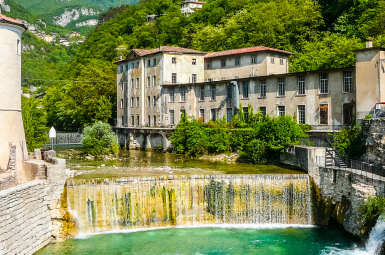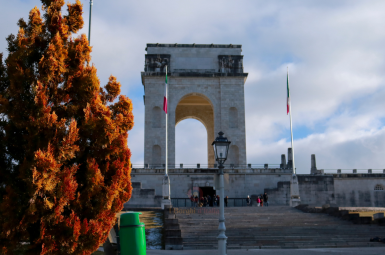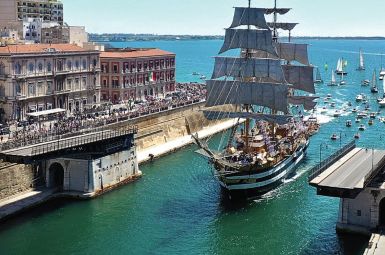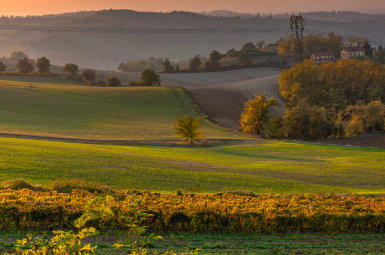
Il Borgo di Gualtieri
Piazza Bentivoglio: La Scena Perfetta
Il cuore di Gualtieri è la monumentale Piazza Bentivoglio, un capolavoro di architettura scenografica tardo-manierista. Progettata tra il 1580 e il 1610 dall’architetto ferrarese Giovan Battista Aleotti detto l’Argenta, la piazza è un quadrato quasi perfetto circondato su tre lati da eleganti portici e scandito dalla maestosa Torre Civica. Questa piazza non era solo un luogo di ritrovo, ma il vero e proprio cortile d’onore del vicino Palazzo Bentivoglio, concepito per esaltare il potere e la visione illuminata della famiglia che bonificò queste terre, trasformando le paludi in fertili campagne.Palazzo Bentivoglio: L’Eredità della Grande Arte
Il Palazzo, che domina un lato della piazza, è un simbolo della grandezza ducale e oggi ospita un eccezionale polo museale.- Sala dei Giganti: Ammira la magnificenza del piano nobile, in particolare la Sala dei Giganti, affrescata con scene del poema epico La Gerusalemme Liberata di Torquato Tasso.
- Sulle Tracce di Ligabue: Il Palazzo è la dimora della Fondazione Museo Antonio Ligabue e del Centro Studi a lui dedicato. Qui, dove il pittore visse i suoi anni più tormentati e creativi dopo l’espulsione dalla Svizzera, si celebra l’opera del “Toni il Matto,” la cui arte potente e visionaria ha saputo catturare l’anima selvaggia del paesaggio padano e la sofferenza umana.
- Collezione Tirelli: Il Palazzo ospita anche la Donazione Umberto Tirelli, grande sarto teatrale e “archeologo della moda” originario di Gualtieri, con una preziosa collezione di abiti d’epoca e dipinti.
Teatro Sociale: Il Mistero del “Rovesciato”
Da non perdere è il suggestivo Teatro Sociale, ricavato all’interno del Palazzo. È noto come il “Teatro Rovesciato” perché la platea e il palcoscenico sono stati invertiti, creando un’acustica unica e un’affascinante anomalia architettonica che sfida le convenzioni. Gualtieri è la sintesi perfetta tra l’ambizione urbanistica del Rinascimento e il genio irregolare del Novecento. Una visita qui è un’esperienza intensa, che ti porta dal classicismo del potere alla tormentata libertà dell’arte naïf.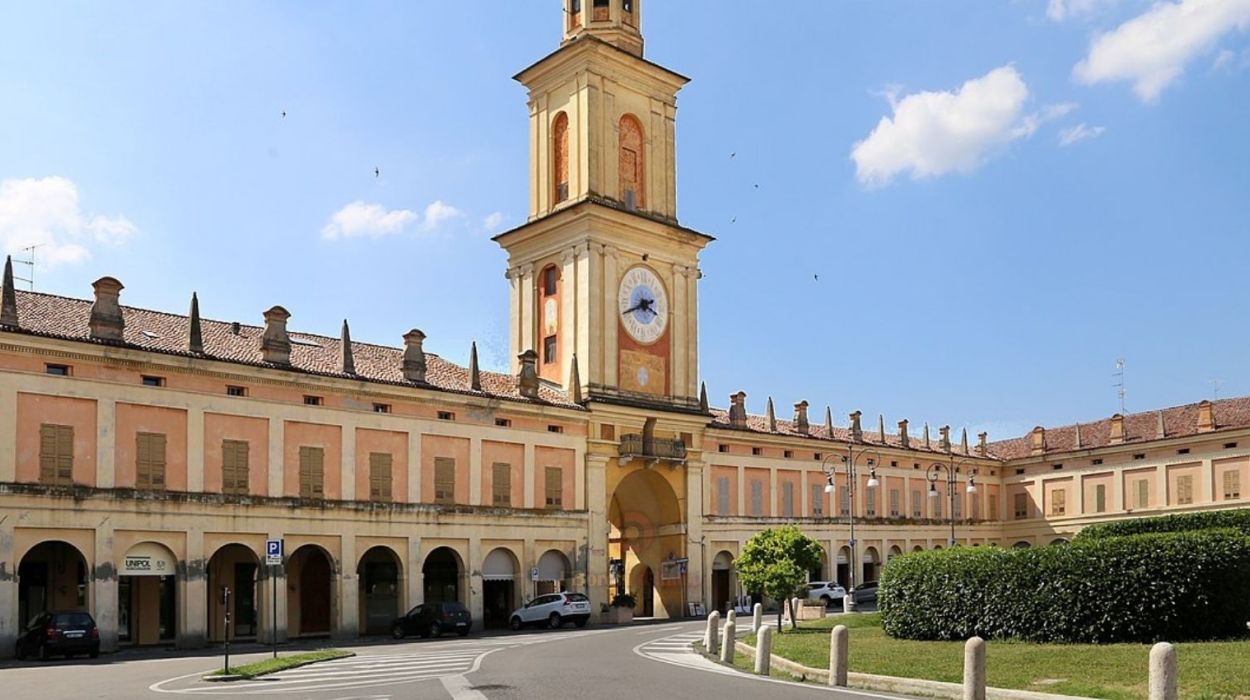
Il Borgo d’Italia
tutto da scoprire ed esplorare
Monumenti
Gualtieri: Il Trionfo del Manierismo nel Borgo Scenografico della Bassa Padana
Gualtieri non è un semplice paese della Bassa Reggiana, ma una straordinaria città ideale concepita per celebrare il potere e la visione estetica della famiglia Bentivoglio. I suoi monumenti sono un’unica, gigantesca, scenografia che unisce architettura, pittura e genio urbanistico del tardo Rinascimento
Piazza Bentivoglio: Il Palcoscenico Perfetto
Il cuore pulsante e la vera meraviglia di Gualtieri è la sua Piazza Bentivoglio, un autentico teatro naturale.
- Geometria Manierista: La piazza è un quadrato perfetto di oltre 94 metri per lato, una dimostrazione di rigore matematico e prospettico. L’ideazione, attribuita all’architetto e ingegnere estense Giovan Battista Aleotti detto l’Argenta, si fonda su elementi del Manierismo che anticipano le scenografie del Barocco.
- Il Portico Continuo: L’intero perimetro, sui tre lati che non sono occupati dal Palazzo, è scandito da un elegante porticato con ampie arcate che offrono una prospettiva continua e avvolgente. Questo loggiato unifica gli edifici e trasforma lo spazio in un grande cortile d’onore a cielo aperto, simbolo del potere assoluto dei Marchesi.
- La Torre Civica: Imponente e visibile da lontano, la Torre dell’Orologio è l’elemento che rompe l’uniformità del portico con la sua mole massiccia e l’ampio arco d’accesso, fungendo da cerniera tra la piazza e il tessuto urbano circostante.
Palazzo Bentivoglio: L’Imponente Residenza Ducale
Il maestoso Palazzo Marchionale domina la piazza, essendo stato la residenza della famiglia che bonificò e riplasmò il territorio.
- Fortezza e Dimora: Progettato anch’esso da Aleotti, fu eretto tra la fine del Cinquecento e l’inizio del Seicento. Nonostante l’aspetto imponente che richiamava una fortezza, il palazzo era il centro della vita culturale e politica. Purtroppo, parte della struttura originaria fu demolita nel Settecento per ricavare materiali utili all’arginatura del fiume Po.
- La Sala dei Giganti: Il vero gioiello del palazzo sono gli interni affrescati, in particolare la Sala dei Giganti. Completamente decorata con un ciclo pittorico dedicato alla Gerusalemme Liberata di Torquato Tasso, è un’opera grandiosa che avvolge il visitatore in una narrazione epica di stampo chiaramente manierista.
- La Casa di Ligabue: Oggi, l’edificio ospita il Museo Antonio Ligabue, un tributo al genio pittorico del Novecento che visse a Gualtieri e che qui trovò l’ispirazione per le sue opere più iconiche, creando un ponte emozionale tra il fasto rinascimentale e l’espressionismo moderno.
Le Gemme Nascoste: Spiritualità e Spettacolo
Oltre al complesso principale, Gualtieri custodisce altri tesori architettonici che ne arricchiscono il fascino.
- Il Teatro Sociale (o “Teatro Rovesciato”): Ricavato all’interno di una delle ali del Palazzo Bentivoglio, il Teatro Sociale è un esempio notevole per la sua storia e architettura. È noto come Teatro Rovesciato perché, durante un ampliamento nel Settecento, fu letteralmente “capovolto” l’orientamento della scena e della platea, un aneddoto che ne sottolinea l’unicità.
- La Collegiata di Santa Maria della Neve: Affacciata sulla piazza, rappresenta il lato spirituale del borgo. Originariamente chiesa parrocchiale e fulcro della vita religiosa, fu costruita e abbellita per volontà dei Bentivoglio come controparte sacra al potere laico del Palazzo.
- La Chiesa di Sant’Andrea: Già esistente nel IX secolo, questa chiesa, pur meno centrale, racconta la storia più antica del borgo. Ricostruita in forme settecentesche a pianta centrale ottagonale, è un bell’esempio di barocco locale.
Curiosità
Gualtieri: Il Borgo di Ligabue, Modellato dal Genio e dal Grande Fiume
Gualtieri è molto più di un borgo storico; è un luogo dove la perfezione geometrica rinascimentale si scontra con l’istinto selvaggio della natura padana, un contrasto che ha ispirato uno dei geni più controversi dell’arte italiana. Preparati a scoprire i segreti e le singolarità di questo gioiello della Bassa Reggiana.
Il Grande Genio e la Sua Bassa
Il nome di Gualtieri è indissolubilmente legato a quello del pittore:
- Antonio Ligabue: L’Eremita della Golena: Gualtieri è la patria d’adozione di Antonio Ligabue (1899-1965), uno dei massimi esponenti della pittura naïf. Espulso dalla Svizzera, “Toni” fu catapultato nella Bassa Reggiana, dove visse un’esistenza solitaria e tormentata.
- La Scenografia delle Belve: Sebbene i suoi quadri raffigurino spesso giungle esotiche e animali feroci, Ligabue non vide mai quei luoghi. Le sue tele sono in realtà la trasfigurazione delle rive solitarie del Po e delle golene di Gualtieri, trasformate dalla sua immaginazione in selvagge savane. L’argine del Po era il suo studio a cielo aperto.
- La Casa e i Conigli: Una curiosità che svela la sua sensibilità è il rapporto con gli animali. Ligabue, che aveva difficoltà a relazionarsi con gli esseri umani, parlava con i suoi conigli e li lavava con meticolosa cura, vedendo in loro gli unici interlocutori fedeli. Oggi, la sua Casa Museo custodisce alcuni dei suoi oggetti e cimeli.
Segreti Architettonici e Sfide del Fiume
La maestosità di Gualtieri nasconde storie di ingegneria idraulica e di architettura ribaltata.
- Il Borgo “Disegnato” come un Teatro: Il centro storico non è frutto del caso, ma di un progetto unitario voluto dal Marchese Ippolito Bentivoglio e disegnato dal celebre architetto Giovan Battista Aleotti (detto l’Argenta). La monumentale Piazza Bentivoglio non è una semplice piazza, ma un perfetto quadrato prospettico concepito per essere un “teatro di corte” all’aperto, un’opera urbanistica che celebrava il potere signorile.
- Il Teatro Rovesciato: All’interno di Palazzo Bentivoglio si trova il Teatro Sociale, che vanta un’identità unica. In seguito a un restauro funzionale, è stato privato del palcoscenico tradizionale e oggi viene utilizzato “al contrario”: dove un tempo c’era il palco ora siede il pubblico, e l’area della platea ospita la rappresentazione. Questo ribaltamento ne fa uno spazio scenico all’avanguardia.
- La Guerra con il Po: La storia di Gualtieri è scandita dalle piene del Grande Fiume. Il paese conserva i segni delle disastrose alluvioni del 1765 e del 1951, i cui livelli massimi sono ancora visibili su alcuni monumenti della piazza. Il fiume ha plasmato la vita del borgo, costringendo i Bentivoglio a intraprendere grandiose opere di bonifica e arginatura, il cui capolavoro ingegneristico è la Botte Bentivoglio, un manufatto idraulico ancora in funzione.
Gualtieri, dunque, è un palcoscenico di contrasti: la razionalità del Manierismo incornicia la genialità irrequieta di Ligabue, tutto a ridosso delle placide e potenti rive del Po. Se visitassi Gualtieri, quali di queste storie ti piacerebbe approfondire per prima?
Personaggi
Gualtieri: Culla di Geni Eretici e Sarti dei Sogni
Gualtieri, con la sua maestosa architettura rinascimentale, non è solo una meraviglia urbanistica. È stata la terra fertile che ha forgiato personalità eccezionali e controverse, figure che, pur partendo dalla Bassa Padana, hanno lasciato un segno indelebile nell’arte, nel cinema e nella cultura mondiale.
Antonio Ligabue: Il Genio Selvaggio della Golena
Sebbene sia nato a Zurigo (1899), la sua storia e la sua arte sono profondamente, quasi visceralmente, legate a Gualtieri, il paese d’origine del padre putativo e il luogo dove fu “rimpatriato” nel 1919, segnando l’inizio della sua vera esistenza.
- L’Identità Trovata nel Po: Il pittore Antonio Ligabue (il cui vero cognome era Laccabue) visse gran parte della sua vita ai margini, tra le capanne e le golene del Po, conducendo un’esistenza “selvaggia” che gli valse il soprannome di Al Matt (il matto) o Al Tedesch (il tedesco) dai suoi concittadini.
- La Nascita dell’Espressionismo Padano: La sua arte, potente ed espressiva, è stata plasmata dal paesaggio gualtierese. Pur non avendo mai visto una giungla, la sua immaginazione trasformò la fitta vegetazione fluviale e gli animali della Bassa nei soggetti preferiti: tigri, leoni e autoritratti che urlano la sua sofferenza e la sua solitudine.
- L’Eredità Viva: Oggi, il Palazzo Bentivoglio ospita la Fondazione Museo Antonio Ligabue, un tributo permanente al grande maestro naïf, che continua ad attrarre appassionati e critici da tutto il mondo.
Umberto Tirelli: L’Archeologo della Moda e Sarto dei Divi
Gualtieri è la città natale di Umberto Tirelli (1928-1990), un nome fondamentale nella storia del costume e del teatro, un artista che ha trasformato il semplice cucito in alta filologia storica.
- Il Sarto che Vestiva la Storia: Tirelli è stato il più celebre costumista italiano del XX secolo, fondatore dell’omonima Sartoria Tirelli a Roma. La sua sartoria è diventata il punto di riferimento internazionale per la creazione di abiti di scena di rigore storico assoluto.
- La Collaborazione con i Grandi: Ha vestito i sogni di registi del calibro di Luchino Visconti, Federico Fellini e Franco Zeffirelli, realizzando costumi iconici per capolavori cinematografici come Il Gattopardo e Amarcord, lavorando al fianco di altrettanto grandi costumisti come Piero Tosi.
- La Donazione al Paese Natio: Si definiva un “archeologo della moda” per la sua instancabile ricerca di tessuti e abiti d’epoca. Per un forte legame con le sue origini, una preziosa parte della sua collezione privata, la Donazione Umberto Tirelli, è ospitata nel Palazzo Bentivoglio, portando così il glamour internazionale nel cuore del borgo.
Giovanna Daffini: La Voce della Lavoratrice
Gualtieri ha dato i natali anche a Giovanna Daffini (1914-1969), una figura emblematica del canto popolare e sociale.
- La Cantante delle Mondine: Daffini è stata una delle voci più autentiche e commoventi della musica popolare italiana. Ha lavorato sin da giovane come mondina nelle risaie del Nord Italia e ha trasmesso, attraverso il canto, le fatiche, le ingiustizie e la solidarietà delle classi lavoratrici, in particolare delle donne.
- Memoria e Tradizione: La sua eredità è fondamentale per la conservazione della memoria storica e musicale della Bassa Padana e delle tradizioni orali del mondo contadino.
Questi personaggi dimostrano come Gualtieri, terra di confine tra l’armonia rinascimentale e l’impeto del Po, sia stata la matrice di spiriti liberi che hanno saputo tradurre la loro esperienza umana in forme d’arte immortali.
Ricette Tipiche
Gualtieri in Tavola: I Sapori Schietti della Bassa Reggiana
La cucina di Gualtieri, incastonata nel cuore della Bassa Reggiana e plasmata dalla vicinanza del Po, è un inno alla generosità della terra e alla sapienza contadina. Qui, l’arte della tavola non è esibizione, ma pura sostanza, dove materie prime eccellenti – dal Parmigiano Reggiano al Lambrusco – diventano l’anima di piatti senza tempo.
I Primi: La Maestria della Sfoglia
Come in tutta l’Emilia, il primo piatto è la tela su cui si esprime l’abilità della zdôra (la reggitrice della casa), con ripieni che raccontano la storia del territorio.
1. I Tortelli di Zucca: Il Dolce-Salato della Tradizione Padana
Se a Mantova e Ferrara i tortelli di zucca sono l’emblema della cucina di corte, a Gualtieri e nella Bassa Reggiana assumono un carattere più popolare ma ugualmente raffinato:
- Il Ripieno: La polpa di zucca violina, cotta a lungo per concentrarne la dolcezza, viene sapientemente mescolata con l’opulenza del Parmigiano Reggiano stagionato. La variante locale spesso include un tocco di noce moscata e, a volte, l’aggiunta di amaretti sbriciolati per quel contrasto agrodolce che è la firma del gusto padano.
- Il Condimento: Vengono serviti, nella loro essenziale perfezione, con un semplice ma ricco condimento di burro fuso, salvia e un’abbondante spolverata di Parmigiano Reggiano.
2. La Pasta Rasa: L’Umile Tesoro in Brodo
Questo piatto è l’esempio lampante dell’inventiva della cucina povera, un’antica minestra che non si trova ovunque:
- L’Essenza: La “pasta rasa” (pastarèsa in dialetto) è un impasto solidissimo di uova, Parmigiano Reggiano e pan grattato. L’impasto viene letteralmente raschiato (o “rasato”) con la grattugia a fori larghi direttamente nel brodo di carne bollente, creando delle briciole irregolari che si cuociono in un lampo, un piatto di grande conforto e nutrimento.
Le Torte Salate e i Tesori della Tavola
La cucina di Gualtieri non si ferma alla pasta ripiena, ma celebra anche i prodotti da forno, perfetti per ogni momento della giornata.
3. L’Erbazzone Reggiano (Scarpazzòun)
La torta salata simbolo della Reggiana, consumata dalla colazione all’aperitivo, è nella Bassa un’istituzione:
- Il Cuore Verde: Un ripieno generoso e compatto di spinaci e bietole lessate, ricotta fresca (o formaggio morbido) e, naturalmente, tantissimo Parmigiano Reggiano.
- Il Carattere Contadino: La sfoglia, spesso semplice o arricchita con un po’ di strutto, viene sigillata e sulla superficie vengono disposti ciuffetti di lardo o pancetta macinata che, sciogliendosi in cottura, conferiscono quel sapore robusto e inconfondibile di terra. La sua crosta esterna sottile racchiude un interno morbido e saporito.
4. Il Lambrusco di Fogarina
Non è una ricetta, ma è il compagno imprescindibile di ogni pasto gualtierese e merita una menzione d’onore:
- Il Vitigno Autoctono: Gualtieri vanta l’orgoglio del Lambrusco di Fogarina, un vitigno autoctono la cui produzione è stata recuperata con passione. Dà vita a un vino rosso, secco e vivace, con sentori caratteristici che riflettono la terra umida e fertile del Po. Perfetto per bilanciare la ricchezza di salumi, tortelli e bolliti.
Questi piatti non sono solo cibo, ma un legame indissolubile con il fiume, la terra e la storia di Gualtieri. Quale di queste specialità le ispira di più per iniziare l’esplorazione gastronomica?
